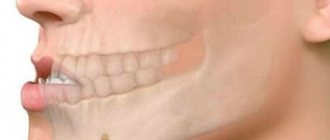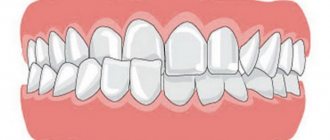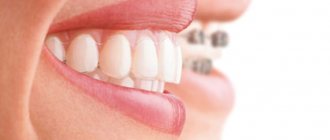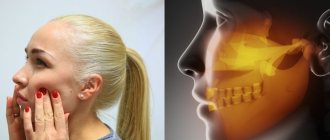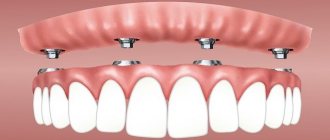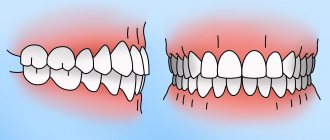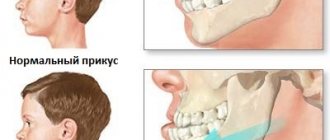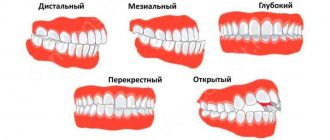A deep bite is a functional disorder in which the upper incisors overlap the lower ones by at least 1/3 of the crown surface when the dentitions are closed. The disease can cause teeth to become loose and fall out at a relatively early age.
What to do if a deep bite develops in adults? How to eliminate a functional disorder? You can get answers to these and other questions by carefully studying the article.
What are malocclusions?
Types of bites
There are several malocclusions, depending on the position of the teeth relative to each other:
- Diastema. A small gap between the front incisors of the upper jaw. It is common in children, but usually goes away by adulthood. But for some, the diastema does not disappear even after the final change of bite, and as a result remains with the person for life.
- Tremes. Small spaces between all other teeth. Also common in children, but sometimes do not go away by adulthood.
- Crowding. With this anomaly, the teeth creep on top of each other due to the fact that there is not enough space for them in the jaw. Often, crowding appears late, when a person begins to erupt in numbers of eights - they press and squeeze the remaining teeth in the row.
- Transposition or dystopia. Teeth erupting in atypical places - above or below the dentition, or even on the palate. This anomaly occurs if there is too little space in the dentition, or if the rudiments of the teeth are not formed correctly. Sometimes supernumerary teeth, that is, extra teeth caused by genetic abnormalities, become dystopic.
- Distal bite. Reduction in the size of the lower jaw, due to which the lower teeth are located far behind the back ones, and the upper ones often protrude forward. This pathology is especially widespread among Europeans and Russians.
- Mesial bite. In this case, the situation is reversed - the upper teeth are hidden behind the lower teeth. This is often accompanied by crowding in the upper jaw, and on the contrary, tremors appear in the lower jaw.
- Open bite. A situation where the teeth do not close together and a gap forms between them. An open bite can occur on both the front and back teeth. It is rare, mainly due to unfortunate heredity, mouth breathing or thumb sucking.
- Deep bite. The upper teeth overlap the lower teeth too much, sometimes even resting on the mucous membrane of the lower jaw.
- Crossbite. The teeth do not close normally, but cross each other, randomly overlapping each other.
These pathologies can exist either separately or together. Sometimes they are practically invisible, and a person may not even know that the bite is broken, although in fact the anomaly exists and requires treatment.
Corrective exercises – myotherapy
As a rule, myotherapy is an addition to the correction of occlusion using various orthodontic devices or as the main method in the treatment of children from 4 to 8 years old. Physical exercises help develop and strengthen facial muscles, stimulate bone growth, and have a positive effect on trophic processes.
Let's look at some effective exercises:
- to correct a deep bite: stand straight with your chin raised as much as possible. Move the lower jaw forward, then return to its original position. Repeat 15 – 17 times;
- to correct open occlusion: take a pencil (you can put a rubber tube on it), squeeze it with your teeth with adequate force. Perform for 4 – 5 minutes;
- with a crossbite: open your mouth as wide as possible, move your jaw towards the defect, close your jaws in the correct position for 5 seconds, then relax, then repeat the exercise again;
- to correct mesial occlusion: use your tongue to press on the inside of the front part of the upper dentition. Perform the exercise for 5 minutes.
Important: when performing any exercises of the myogymnastics complex there should be no pain. After each approach, you need to let the muscles relax for 1 minute.
Causes of malocclusions
Types of malocclusion
There are many causes of malocclusion. They can be divided by age groups.
In childhood, the bite is disrupted for the following reasons:
- Various genetic abnormalities.
- Unlucky heredity - the parents have an incorrect bite, or the child received too small a jaw from his mother and too large teeth from his father.
- The child’s habit of breathing with his mouth open, sucking fingers or a pacifier after teething.
- Early loss of baby teeth due to caries or their removal instead of treatment.
- Incorrect attachment of the frenulum of the tongue or lips, creating pressure on the teeth.
If these negative factors were not present in childhood, then by adulthood a person’s bite usually remains normal. However, it may fail for the following reasons:
- Jaw injuries, especially those accompanied by tooth loss.
- Extraction or loss of teeth - adjacent teeth will move to take up the vacant space.
- Inflammation of the gums, accompanied by loss of bone tissue - teeth become loose and shift.
- Eruption of wisdom teeth, especially if there is no room for them in the jaw.
In this case, the bite can deteriorate at 20, 30 and even 40 years of age.
Photos of correcting crooked teeth in children
When milk teeth are removed early, the teeth behind them move forward, to the place of the removed ones, and occupy a “foreign” place. In this case, the primary canine was lost prematurely; its place was completely covered by the teeth behind it, thereby completely “taking” the place from the permanent canine. Fortunately, the orthodontist managed, with the help of a removable appliance, to move the entire segment posteriorly and get a place for the fang!) It didn’t take long to wait and soon erupted into the oral cavity! Of course, the work is not finished yet, but most of it is done!
Why is it necessary to correct your bite?
If a malocclusion bothers a person from an aesthetic point of view, he will, of course, want to correct it. But there are people who do not care about their crooked teeth, and it seems that in this case it is not worth starting orthodontic treatment. But in fact, an incorrect bite can cause other problems besides aesthetic ones.
Due to the fact that the teeth are positioned incorrectly, the chewing load is abnormally distributed between them. As a result, some teeth wear down, while others are less involved in chewing, which is why the bone tissue underneath them atrophies. This leads to frequent caries, sensitivity and loose teeth. In addition, protruding teeth can injure the cheeks, gums and tongue, causing various inflammations to appear in the mouth.
With an incorrect bite, not only the teeth are incorrectly positioned, but also the jaws themselves. Because of this, the functioning of the temporomandibular joint is disrupted. This leads to problems opening the mouth, clicking of the jaw, and sometimes even severe pain.
Among other things, malocclusion can cause two more serious global problems:
- Gastrointestinal diseases. Sometimes people with uneven teeth find it difficult to chew food thoroughly. As a result, it enters the stomach insufficiently crushed, causing frequent disorders and other problems.
- Headache. Due to improper jaw alignment, people with bad teeth often suffer from migraines and pain for no apparent reason.
Well, the last but not least important problem is that an incorrect bite interferes with prosthetics. When one or more teeth are lost due to malocclusion, it is often difficult to place a bridge, crown or implant - the neighboring teeth get in the way. And since almost everyone has to get dentures as they age, an incorrect bite can make this process much more difficult, so it’s best to take care of correcting it in advance.
Why do braces change your appearance?
Not everyone knows that dental problems deform the face, adding asymmetry to it. Missing and long-term non-renewable teeth, malocclusion and periodontal diseases disrupt chewing function and overload individual teeth and facial muscles.
Aesthetic sapphire and ceramic braces, systematically correcting defects, strengthen the soft tissue framework, which includes skin, subcutaneous fat and muscles. Teeth moving into correct positions changes the position of the jaws and joints. As a result, muscles and ligaments are loaded evenly, sagging skin is tightened, and the fat underneath is redistributed.
Therefore, in parallel with the correction of dental anomalies, the shape of the face also changes. The degree of severity of the correction is determined by the individual characteristics of the dental system. But the accumulated experience and numerous photos before and after braces allowed specialists to formulate the general principles of the changes taking place.
Diagnosis of malocclusions
Sometimes malocclusions are completely obvious to the patient - for example, it is easy to notice a diastema or serious problems such as crowding or crossbite. But sometimes the anomalies are minor and are hidden in the area of the chewing teeth. In this case, a person can live and not even know that his bite is incorrect.
Such defects are not noticeable, even to others, but are no less harmful to health than noticeable ones. Since it is impossible to recognize them on your own, it is better in this case to consult a doctor.
Usually, even a dentist can recognize such minor bite defects during a routine examination or during caries treatment. In this case, he informs the patient, describes the defect in the medical record and prescribes treatment with an orthodontist.
Sometimes malocclusions are difficult to recognize, so if the therapist finds nothing, it makes sense to visit an orthodontic specialist once, just in case, so that he can conduct a thorough examination and accurately determine whether you have problems with your bite. For diagnosis, visual examination, x-rays and computed tomography are used.
The bite can change throughout life, so it is important to visit a doctor every six months to a year. At preventive appointments, the dentist carries out cleaning, diagnoses caries and can immediately notice the slightest changes in the bite, which will be very easy to correct at the initial stage.
Facial asymmetry
Some discrepancy in the size of the right and left halves of the face is normal. Not so long ago, the predominance of emotional and rational principles in a person was judged by the width of which side predominated. The skeletal anomaly underlying the formation of a crossbite significantly increases facial asymmetry, which deprives a person of attractiveness.
Asymmetry is revealed during external examination. During the dental examination, the doctor determines the presence of a displacement of one jaw relative to the other, which is accompanied by a change in the relative position of the dentition; one of the dentition may be expanded or, conversely, narrowed. Malocclusion leads to impaired diction, swallowing, and rapid abrasion of the enamel of the chewing surfaces of the teeth.
What is the problem with bite correction in adults?
The opinion that malocclusion can only be corrected in childhood did not appear without reason. The fact is that in childhood a child’s jaw is indeed much more plastic and more amenable to change, since it is still growing. Therefore, the age of up to 15–16 years is the best time to correct your bite.
In a teenager, teeth move willingly and are easily fixed in their places, so treatment with braces rarely takes more than a year, and it is very easy to consolidate the results of treatment.
In an adult, the jaw no longer grows, so the situation is more complicated. You can’t just “spread” your teeth; bite correction takes from one and a half to two, sometimes up to three years. And if there is no room for teeth in the jaw, then some have to be removed altogether, which further complicates the treatment.
In addition, adult teeth are already set in place, so if they are moved, they will want to move back. Therefore, after long-term treatment, it takes at least a long time to consolidate the results - sometimes it takes two, three or four years, and in difficult cases, you will sometimes have to wear temporary structures all your life that prevent the teeth from moving again to the wrong places.
But all this does not mean that bite correction in adulthood is impossible. Yes, it is a little more complicated and takes more time, but it is a completely working procedure that is accessible to any adult, without exception.
Is it possible to correct an adult’s bite on their own?
In childhood, even before the eruption of permanent teeth, you can set the right direction for the development of your bite on your own. For this purpose, the child is relieved of bad habits and is also forced to wear special trainers that reduce pressure on the teeth.
In adulthood, the situation, unfortunately, is more complicated. The bite has already fully formed, and all that can be done is to go to the orthodontist so that he can prescribe and install devices for its correction.
Mouth guards for bite correction
Sometimes on the Internet you can find supposedly universal mouth guards for sale that “help” correct the bite in adults. But all anomalies are individual, and in order to correct a defect in a particular person, you need to make a device individually for his bite. Therefore, all “universal” devices are not suitable, and there is no way to correct the bite at home - you must definitely go to an orthodontist.
Prices
Today, the minimum cost of a brace system to correct a bite is fifteen thousand rubles. It is worth understanding that this price includes not only the cost of braces, but also the cost of diagnostics, maintenance (activation) of the brace system and a treatment plan, which depends on each specific case. And for treatment without braces, the cost depends largely on the device chosen. You can view the detailed price list on our website in the “Prices” section.
We recommend that you make an appointment with an orthodontist at any of our clinics, the addresses and telephone numbers of which are listed in the “Contacts” section.
Bite correction using braces
Braces for correcting malocclusion
The most common way to correct a malocclusion in adulthood is to install braces. Braces are clasps that are attached to the teeth and connected to each other by a metal arch.
There are several types of braces with their own characteristics, advantages and disadvantages.
Metal
metal braces
Both the clasps and the bow are made of metal. Such braces are considered classic; they are most often installed because of their versatility and cost-effectiveness.
Pros:
- Suitable for any malocclusion.
- High strength.
- Low cost.
- The fastest bite correction.
Minuses:
- Lowest aesthetics - braces are too noticeable.
- Unpleasant taste and sensation in the mouth.
- They are not suitable for people with metal allergies - they have to select alloy options, often more expensive.
Ceramic
Ceramic braces
In this case, braces are made of ceramic, similar in color to tooth enamel. The arc remains metal, but is painted white.
Pros:
- Quite high aesthetics, braces are almost invisible.
- Less likely to cause irritation and allergies.
Minuses:
- They cost more than metal ones.
- More fragile, treatment takes longer.
- Not suitable for the most severe malocclusions.
Sapphire
These braces are made from artificial sapphires - they are transparent and shiny, like diamonds.
Pros:
- Aesthetic - relatively noticeable, but look like a decoration for the teeth.
Minuses:
- More expensive than metal and ceramic.
- More fragile.
Combined
Combined braces
An option in which ceramic or sapphire braces are installed on the front (usually only the upper) teeth, and metal structures on the back (and lower) teeth.
Pros:
- Quite high aesthetics - the side teeth are still not visible when smiling and talking.
- The cost is lower than braces made entirely of ceramics or sapphires.
- Copes with most malocclusions.
Minuses:
- They still cost a little more than regular metal braces.
- They are not suitable if the bite is seriously disturbed on the front teeth.
- Still uncomfortable if you have a metal allergy.
Lingual
Lingual braces
These are ordinary metal braces that are installed not in front, but in the back, on the side of the tongue.
pros:
- Complete invisibility.
- An excellent effect in correcting some malocclusions - for example, they do a good job of moving the jaw forward.
Minuses:
- The tongue is often injured and diction is impaired.
- They are more expensive than all types of braces.
- Ineffective for many malocclusions.
- Not suitable for people with metal allergies.
Plastic
These braces are made of light plastic, but they are installed very rarely due to numerous shortcomings.
Pros:
- Lowest cost.
- Relative aesthetics - for some time they are invisible on the teeth.
Minuses:
- Fragility - braces break easily and are not suitable for most malocclusions.
- Over time, the plastic absorbs food coloring and darkens, so that the braces are no longer aesthetically pleasing.
- Sometimes plastic causes allergies.
You cannot choose braces on your own; you need to do this together with your dentist. After he examines your teeth, he will make a conclusion whether you can get any other braces other than metal ones, whether lingual braces are right for you, and what type of design will be most effective in your case.
Classic metal braces cope with most malocclusions, so if the result is more important to you than aesthetics, it is better to use them.
How much does orthognathic surgery cost in Krasnodar?
The cost of the operation includes the operation itself and the post-operative period.
Orthognathic surgery without a postoperative period costs about 200 thousand rubles. The postoperative period will cost about 100 thousand rubles.
Patients in most cases are satisfied with the surgical intervention. They note an improvement in their quality of life. But for some, the disadvantage of this type of operation is the high cost. Since this type of operation is a planned operation of moderate severity, it is possible to carry it out under compulsory medical insurance. The waiting period can be more than 6 months.
Correction of adult occlusion with removable aligners
Braces are not convenient for everyone - they still interfere with proper dental care and in most cases are noticeable to others. Therefore, there is another way to correct bite in adults - transparent removable aligners.
Such mouthguards are made individually, according to the patient’s jaw model. They are made of transparent plastic, which is designed in such a way that it puts pressure on the teeth in much the same way as the arch of braces does. The aligners are changed during the treatment to more and more rigid ones, and in the end the teeth are in the correct position.
Advantages
- Inconspicuous compared to many other types of braces.
- Possibility to remove while brushing teeth and eating.
- Easy care.
- They do not cause pain and do not scratch gums and cheeks.
- Suitable for people with metal allergies.
Flaws
The cap has one significant drawback. Plastic cannot act as strongly as metal, so aligners unfortunately cannot cope with serious abnormalities such as crowding or crossbite. They are also not suitable for changing the position of the jaws relative to each other, since the aligners of the upper and lower jaws are not connected to each other.
Another disadvantage is that mouth guards are only suitable for disciplined people. If you forget to put them on a couple of times, the treatment will have to start almost from scratch.
The last disadvantage is that the cost of the mouth guards is comparable to the most expensive types of braces. Considering that they only correct minor bite defects, such an expense may seem unjustified.
Errors in the treatment of distal occlusion
The first, main mistake is that many try to treat distal bite with one device. For example, only with braces (this is the most popular option). But braces, although a cool device, are not for skeletal problems. The level of hardware competence of the braces system does not extend further than “to place the teeth on the jaw.” And distal occlusion, as we have already said, is a purely skeletal problem. Jaws and posture are to blame. And braces are not capable of solving problems with posture or jaw problems. After all, braces cannot change the position or size of the jaw. No matter what the would-be doctors promise...
And therefore, such videos are just an advertising gimmick.
Or rather, a convenient “hook” that catches gullible patients. Convenient because it coincides with the desire to do everything quickly and efficiently... But it doesn’t coincide with reality.
And braces cannot be the main device in the treatment of distal occlusion.
Braces are the wrong choice when treating distal malocclusions. In any case, you definitely shouldn’t start with them. Braces, as mentioned and shown above, can be effectively used only at the final stage of treatment of distal occlusion. All major “feats” must be accomplished before working on the teeth. Before using braces. And they are accomplished at the level of the jaws and skeleton (posture). Otherwise, there will simply be nothing to “clog” (close) these teeth (read with braces). See “Fundamentals of the therapeutic concept of “Ortho-Arteli”.
The second common mistake in correcting distal occlusion is treatment with the removal of upper premolars (4 or 5 teeth).
And this mistake is much more serious. Because it can have the most dire consequences. See "Orthodontic treatment with tooth extraction."
After all, as we said above, the main causes of distal occlusion are skeletal. And most often the lower jaw is to blame. And if so, then a reasonable question arises: if the lower jaw is to blame, what does the upper teeth have to do with it (their removal). Where is the logic?
In general, all errors in the treatment of distal occlusion in an adult are usually associated with insufficient diagnosis. Which entails a misunderstanding of the reasons for the occurrence of distal occlusion in each specific case.
For example, the “dental” cause of distal occlusion is very often confused with the “skeletal” (jaw) cause. We remind you that in the first case you need to move the lateral teeth back. And in the second - to push the lower jaw forward and develop the upper one. And if you get confused, if you don’t figure it out... Start distalizing the upper teeth, or worse, remove them when it is necessary to advance the lower jaw... Or vice versa. It is clear that nothing good will come of it.
The third mistake is when, without understanding what’s what, what exactly is the cause of distal occlusion, but realizing, however, that the problem cannot be corrected with braces, they try to solve the problem surgically. Using orthognathic surgery. Through osteotomy of the lower and upper jaws.
This is where I would like to dwell in more detail. And explain something. Why do orthodontists send to a surgeon to “treat” a distal bite? They have already said: they understand that braces will not cope. But they don’t understand how to treat it without braces. They don’t understand because in dentistry in general, and orthodontics in particular, there are a lot of prejudices regarding the possibilities of moving the lower jaw forward and developing the upper jaw. And these, as we saw above, are the main (“key”) points in the treatment of distal occlusion.
Most orthodontists simply do not believe in this (that it is possible in principle). Because someone (even a “great one”) said two hundred years ago that this cannot be done. Time has passed. Everyone has already forgotten why it is “impossible”. But no one even bothered to check why, in fact, it was impossible...
And therefore, those doctors who blindly believe in these moss-covered “dogmas” simply do not see an alternative. And for them there are only two extreme poles in the treatment of distal occlusion: braces and surgery. That's all.
During a direct examination by a specialist, you will be able to find out your exact diagnosis, as well as receive a referral for diagnosis or a treatment plan.
And in our clinic we treat distal occlusion between these two poles. Using methods of maxillofacial orthopedics and craniodontics. Here are the ones: changing the position of the lower jaw and changing the size of the upper. And we get good results, without regard to the fact that someone once said something... We must always double-check what was said. We checked. And everything turned out to be somewhat different. Or rather, not at all the way they “frightened” us. You can also push it out. It can be developed. You just need to know how, because there are some “secrets” here. And we, at the Orto-Artel clinic, knowing these “secrets”, take advantage of these opportunities, successfully eliminating distal occlusion of any complexity.
By the way, if we are talking about surgical treatment of distal occlusion, then we need to determine when and in what cases surgery is generally appropriate. But the indication is basically the same - a small lower jaw, the so-called lower micrognathia, and the micrognathia is very pronounced.
We indicated this reason above as one of the skeletal reasons. I will add: the lower jaw should be VERY short. Literally ugly. Only then can this be resolved surgically. In all other cases, you can do without surgery. Proven and tested many times.
By the way... In our clinic, a good half of the patients have formal indications for surgical treatment of distal occlusion. But only a few got to the surgeon. Because formalities are formalities, but compromise solutions were found that satisfied everyone: both the patients and us. This is because we approach treatment not formally, but in essence. And we are guided by logic and common sense.
Well, as a special case of a short lower jaw, which cannot be corrected except by surgery, this is a small chin. If it is small and spoils the face, then even by pushing the lower jaw forward we will not get the aesthetics we want. Simply because orthodontists do not have the means and instruments (devices) to selectively influence the chin. It is impossible to stimulate the chin to grow. Only surgery.
Inferior micrognathia.
This is where the indications (and there is essentially one) for surgical intervention for distal occlusion end.
Going with a knife into the upper jaw - God forbid! Even if the upper jaw is indirectly to blame for the distal occlusion. More precisely, the upper jaw also, as a rule, suffers (dimensionally) with distal occlusion. The upper jaw is directly connected to the base of the skull. And such interventions can then backfire. Literally. And the most important thing is that there is no need to go there surgically. The upper jaw can be developed!!!
Bite correction with adult veneers
Sometimes bite defects in adults are very minor and purely cosmetic - for example, there are gaps between the front teeth, or some teeth are slightly shorter or longer than others. Such defects in the smile area are not dangerous to health, but seriously spoil aesthetics.
To eliminate them, it is not necessary to carry out full-fledged long-term orthodontic treatment. Defects can be masked with veneers - ceramic plates that are installed on the teeth and completely cover them. Veneers can be made slightly wider or longer than natural teeth, and thus cover all defects.
In addition, if you put veneers on all your front teeth, you can create the effect of a snow-white Hollywood smile - they will mask all the darkening and enamel defects, making your teeth perfect in every sense.
Ceramic
These systems are valued for their aesthetics and relative invisibility on dental surfaces. Ceramic plates can be made to match the patient’s tooth enamel, and therefore the choice in favor of ceramic braces when correcting a bite is made by those people who would like to hide the fact of undergoing orthodontic treatment from others. The price of ceramic braces in Moscow starts from 75,000 rubles;
Maintaining the result after bite correction
As we noted above, when correcting occlusion in adults, it is especially important to consolidate the result after treatment. Since the jaw has long been formed, the teeth have already become “accustomed” to their incorrect position, and after removing the braces or aligners they will want to return to it.
To prevent this, there is a retention period - a stage of treatment during which the patient wears retainers. These are also orthodontic structures, but much simpler and more convenient than braces and mouth guards.
Retainers come in two main types:
- Removable, in the form of caps, plates or wire structures. They need to be worn sometimes, for example, at night. Such designs are convenient and do not interfere with brushing your teeth, but it is important not to forget to wear them, otherwise your teeth will return to the wrong position.
- Fixed, in the form of a thin wire that is attached to the back of the teeth. They are covered with a composite, invisible and at the same time reliably hold the teeth together. These retainers are convenient, although they make it a little difficult to brush your teeth and are not suitable for all malocclusions.
Typically, the retainer needs to be worn one and a half to two times longer than the braces treatment lasted. That is, if the bite has been corrected for two years, you will have to wear a retainer for another 3-4. This sounds inconvenient, but in fact it is not too burdensome. In addition, during this period you will no longer need to visit a doctor.
It is very important not to neglect the retention period. Sometimes it seems that the bite has already been corrected, why torture yourself by wearing some kind of construction? But if the teeth return to their incorrect position, the entire orthodontic treatment will have to be repeated again - that is, you will have to wear braces again for 1-2 years, and then still wear a retainer.
What is mesial occlusion?
Mesial occlusion is an umbrella term for several similar anomalies, the main distinguishing feature of which is a noticeably protruding lower jaw. This type of curvature is also very often called progeny, and is divided into true and false. As a result of true progeny, improper closure of the teeth occurs due to an overdeveloped lower jaw or part thereof. A false anomaly, on the contrary, appears during underdevelopment of the upper jaw or due to constant protrusion of the lower jaw. With a mesial bite, the front teeth practically do not touch each other, and the back teeth close incorrectly.
It is possible to eliminate progeny without surgical intervention only during the period of skeletal formation, that is, in childhood and adolescence, and the sooner treatment begins, the easier it will be.
How to prevent malocclusion in adulthood
If you are lucky and by the age of 18–20 you have a completely normal bite, this can be maintained until old age. To do this, you need to follow the following recommendations:
- Visit the dentist every six months to a year. He recognizes malocclusion at an early stage, and also notices in time any diseases that can lead to tooth loss and malocclusion.
- Treat any diseases of the teeth and gums in a timely manner. Untreated caries or gingivitis can ultimately easily lead to tooth loss, and therefore to malocclusion.
- Find out in advance about the condition of your wisdom teeth. If the eights have not yet erupted, you should go to the doctor and get an x-ray to see if they are growing sideways or putting pressure on neighboring teeth. It may be better to remove these teeth. If they begin to erupt, you should also consult a dentist to understand whether eruption is proceeding normally.
- Avoid jaw injuries. Protect your face while playing dangerous and contact sports.
- Eat solid foods more often: vegetables and fruits. This keeps teeth in “working” condition and helps keep them healthy longer.
- Do not bite hard objects with your teeth or open bottles. Because of this, teeth can easily break off and become destroyed.
- If a tooth is lost, a prosthesis should be installed immediately to prevent other teeth from moving into the resulting space.
Types of crossbite
Correction of crossbite, the method of treatment will depend on the established type of anomaly. And the types of cross occlusion are as follows:
- buccal
_ Narrow underdeveloped upper jaw and enlarged mobile lower jaw. There is bilateral overlap and unilateral overlap, with or without displacement of the dentition. With this occlusion, the bottom overlaps the top. - lingual
_ The upper jaw is widened and less mobile, so it is covered by the buccal tubercles on top. Pathology can be one- or two-sided. - buccal-lingual
- combining the two above-mentioned types of crossbite, its treatment is much more complicated.
According to etiology, the type of atypical bite is classified into:
- gnathic
- pathology of the jaw shape; - dentoalveolar
- irregular sizes of teeth, roots and alveolar arches; - articular
- jaw shift, TMJ disorder.
Options for combining deocclusions are common, and mesial crossbite is not uncommon.
Reviews about bite correction
Reviews of bite correction for adults confirm that this is not a hopeless matter - almost everyone eventually managed to achieve a perfect smile. Here are typical examples of reviews:
“I got regular metal braces to save money. I had to wear them for two whole years, then I wore the plate for another two years, but I only put it on at night, there were no problems. Now five years have passed since the treatment, my teeth are straight, everything is fine. I won’t say that there were any special problems, but I’m happy with the result.”
“To be honest, the braces themselves were terrible (Well, for me, at least. Brushing my teeth was inconvenient, in the first two weeks everything hurt. Then I got used to it, but my cheeks still sometimes scratched, I had to cover it with wax. And even though they were ceramic, people "They still noticed it around me. But I think it’s worth it - now I’ve taken off my braces and my teeth are perfectly straight! They installed a permanent retainer, but I hardly feel it, no inconvenience. So I think it was worth the patience."
“My teeth were just a little uneven, but it was annoying. I went to the dentist, and in the end they agreed on mouthguards - I can’t afford to wear braces. As a result, the treatment went unnoticed not only for those around me, but even for me - no pain, no discomfort, I can take it off and eat whatever I want, brush my teeth in peace. Remembering how I wore braces for six months as a child and comparing, I understand that in general everything went without problems. Now I wear other mouthguards to secure them, but they are still very comfortable.”
There are practically no negative reviews about bite correction. Yes, patients complain about pain and inconvenience, but in the end they are still satisfied with the result and maintain a beautiful smile for life.
Progress of the operation
Surgical correction of the bite is carried out in our clinic under general anesthesia under the guidance of an experienced chief physician and anesthesiologist-resuscitator and orthodontist. The duration can take from 15 minutes to 4 hours in complex cases. The operation itself includes the surgical stage itself, when access to the bone is carried out surgically through soft tissue in order to correct its position. The surgeon performs manipulations to reduce or increase the volume of bone tissue, or to displace it using a special surgical set and elements for fixing the bone (various splints, screws).
If the patient’s condition allows and there is a need, braces are installed immediately after surgery. After surgery, a fixing bandage is applied to the face. Sutures are placed on soft tissues, and the wound surface is treated.
In complex clinical cases, due to the proximity of other organs to the operated area, we involve the appropriate specialists - ophthalmologists, plastic surgeons, otorhinolaryngologists.
Since the operation is performed exclusively under general anesthesia, it is painless for the patient, under constant monitoring of the condition of vital organs and systems by an anesthesiologist.
